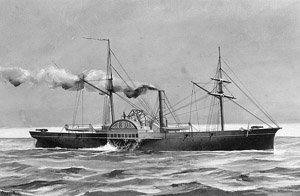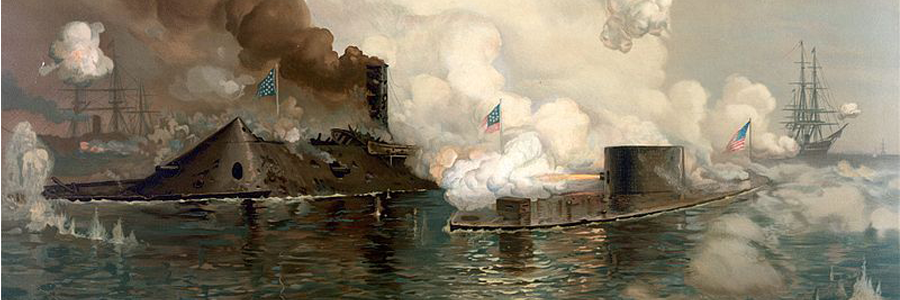
The ironclads were the result when industrialism and naval warfare finally merged in the late 1850's. In a quarter century capital ships went from all-wood sailing ships to iron-armored, steam powered battleships with gun turrets and super heavy guns.

CSS Patrick Henry
Confederate Secretary of the Navy Stephen R. Mallory ordered her to slip out of the James River in Virginiaand to capture some of the U.S. Navy's chartered cruisers. It should surprise no one to find out that the C.S.S. Patrick Henry never made it out of the James River. The CSS Patrick Henry was a powerful vessel. She weighed 1300 tons, was 250 feet long, and 34 feet at her widest point. The Confederates had armed the ship with one 10-inch smoothbore (less acturate and distance than an rifle bore) as forward pivot gun, a 64-pounder gun as after pivot gun, and eight medium weight 32-pounder guns along her sides. Formidable enough for a Confederate vessel early in the war, but no match for the Federal fleet in Hampton Roads.
Development of the Ironclads in the Civil War
The American Civil War, fought between 1861 and 1865, came at a time of transition from ships of wood and men of iron to ships of iron and men of less sturdy composition. The war gave rise to a unique outburst of experimentation in ship design, with a great variety of new types of ships entering service. While the USS Monitor foreshadowed subsequent developments, most of the vessel archetypes of this epoch did not survive the Civil War.
The great Civil War was remarkable for the extraordinary mixture of inventive mechanical genius and of resolute daring shown by the combatants. After the first year, the battles were marked by their extraordinary obstinacy and heavy loss. In no European conflict since the close of the Napoleonic wars has the fighting been anything like as obstinate and as bloody as was the fighting in our own Civil War. In addition to this fierce and dogged courage, this splendid fighting capacity, the contest also brought out the skilled inventive power of engineering in a way that few other contests have ever done.
This was especially true of the navy. The fighting under and against U.S. Admiral David Farragut (1) and his fellow-admirals revolutionized naval warfare. The Civil War marks the break between the old style and the new. Terrible encounters took place when the terrible new engines of war were brought into action for the first time; and one of these encounters has given an example which, for heroic daring combined with cool intelligence, is unsurpassed in all time.
Both sides, but especially the Confederates, used stationary torpedoes, and, on a number of occasions, torpedo-boats likewise. Torpedoes had been tried in the Revolutionary War, but their failure prevented it going further and it also was considered dishonorable to blow a ship up with a powder-can concealed under the water.
The Confederate torpedo boats were sometimes built to go under the water. One such as the CSS Hunley, after repeated failures and losing 13 men up to this point), was used by the Confederates, with equal gallantry and success, in sinking a Union sloop of war off Charleston harbor, but the Hunley was loss to sea after the battle and losing another 8 men to the sea. The other type of torpedo-boat was simply a swift, ordinary steam-launch, operated above water.
At the outset of the War Between the States, neither side possessed the material nor manpower required for what would prove to be the first modern industrialized war. The North at least had a navy, and over 250 Union warships were soon on active duty blockading the coasts and rivers of the South. The Confederates conversely had no adequate shipyards except the captured naval yard at Norfolk and not one workshop capable of building an engine large enough to power a warship.
Notes: - (1) Admiral David Farragut is remembered for his famous order at the Battle of Mobile Bay, usually paraphrased: "Damn the torpedoes, full speed ahead!"
